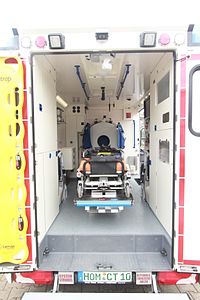
Photo from wikipedia
Abstract Background Lower socioeconomic status (SES) is associated with higher mortality rates and the likelihood of receiving less evidence-based treatment after stroke. In contrast, little is known about the impact… Click to show full abstract
Abstract Background Lower socioeconomic status (SES) is associated with higher mortality rates and the likelihood of receiving less evidence-based treatment after stroke. In contrast, little is known about the impact of SES on recovery after discharge from inpatient rehabilitation. The aim of this study was to investigate the influence of SES on long-term recovery after stroke. Patients and methods In a prospective, observational, multicentre study, inpatients were recruited towards the end of rehabilitation. The 12-month follow-up focussed on upper limb motor recovery, measured by the Fugl-Meyer score. A clinically relevant improvement of ≥5.25 points was considered recovery. Patient-centric measures such as the Patient-reported Outcomes Measurement Information System-Physical Health (PROMIS-10 PH) provided secondary outcomes. Information on schooling, vocational training, income and occupational status pre-stroke entered a multidimensional SES index. Multivariate logistic regression models calculating odds ratios (ORs) and corresponding confidence intervals (CIs) were applied. SES was added to an initial model including age, sex and baseline neurological deficit. Additional exploratory analyses examined the association between SES and outpatient treatment. Results One hundred and seventy-six patients were enrolled of whom 98 had SES and long-term recovery data. Model comparisons showed the SES-model superior to the initial model (Akaike information criterion (AIC): 123 vs. 120, Pseudo R 2: 0.09 vs. 0.13). The likelihood of motor recovery (OR = 17.12, 95%CI = 1.31; 224.18) and PROMIS-10 PH improvement (OR = 20.76, 95%CI = 1.28; 337.11) were significantly increased with higher SES, along with more frequent use of outpatient therapy (p = .02). Conclusions Higher pre-stroke SES is associated with better long-term recovery after discharge from rehabilitation. Understanding these factors can improve outpatient long-term stroke care and lead to better recovery. KEY MESSAGE Higher pre-stroke socioeconomic status (SES) is associated with better long-term recovery after discharge from rehabilitation both in terms of motor function and self-reported health status. Higher SES is associated with significantly higher utilization of outpatient therapies. Discharge management of rehabilitation clinics should identify and address socioeconomic factors in order to detect individual needs and to improve outpatient recovery. Article registration: clinicaltrials.gov NCT04119479.
Journal Title: Annals of Medicine
Year Published: 2022
Link to full text (if available)
Share on Social Media: Sign Up to like & get
recommendations!